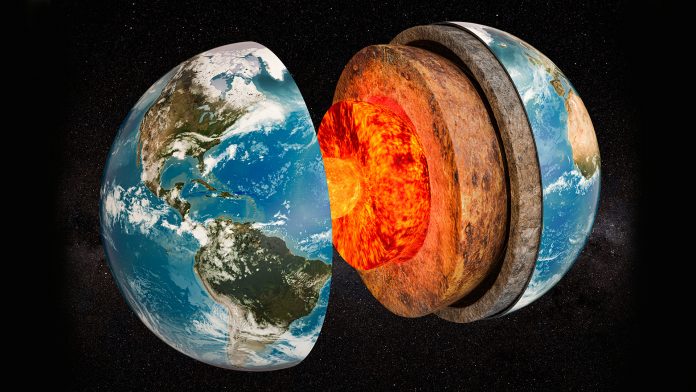Geologists at Goethe University, Frankfurt, have discovered that the transition zone between Earth’s upper and lower mantle contains considerable amounts of water.
To reach this conclusion, the researchers studied a rare diamond only found in pieces of Earth’s mantle. The diamond’s chemical composition proved this, as its structure was virtually the same as pieces of mantle rock found in basalts across the world.
They discovered that the stone contained numerous ringwoodite inclusions, a high-pressure phase of magnesium silicate, which exhibited a high water content.
“In this study, we have demonstrated that the transition zone is not a dry sponge, but holds considerable quantities of water. This also brings us one step closer to Jules Verne’s idea of an ocean inside the Earth,” said Frank Brenker, from the Institute of Geosciences at Goethe University.
Movement of materials within Earth’s transition zone
The transition zone refers to the boundary layer that separates Earth’s lower and upper mantle. The zone is located at a depth of 410 to 660 kilometres within the mantle. The green mineral olivine, which constitutes around 70% of our planet’s upper mantle, is caused by immense pressure that builds up in the transition zone.
The researchers found that olivine is converted into denser wadsleyite at the top of the transition zone, before morphing into even denser ringwoodite at around 520 kilometres deep.
“These mineral transformations greatly hinder the movements of rock in the mantle,” Brenker explained. “Rising columns of hot rock deep within the mantle sometimes stop directly below the transition zone, also bringing the movement of mass in the opposite direction to a standstill.
“Subducting plates often have difficulty in breaking through the entire transition zone. So, there is a whole graveyard of such plates in this zone underneath Europe.”
Until now, scientists were unaware of what impact the movement of material within the transition zone had on its geochemical composition, or whether large quantities of water existed there.
“The subducting slabs also carry deep-sea sediments back into the Earth’s interior. These sediments can hold large quantities of water and CO2,” Brenker explained.
He continued: “But until now, it was unclear just how much enters the transition zone in the form of more stable, hydrous minerals and carbonates – and it was therefore also unclear whether large quantities of water really are stored there.”
The discovery of water in the transition zone
The discovery of dense materials, such as wadsleyite and ringwoodite, helped the team to discover the large volumes of water stored in Earth’s mantle. Unlike the olivine at lesser depths, these materials are able to store large quantities of water.
Their absorbency levels are so high, that the mantle and its transition zone would be able to absorb six times the amount of water in our oceans. While the scientists were aware that the boundary layer had an enormous capacity to store water, they were unaware if it actually did, until they analysed the mantle diamond.
Hydrous ringwoodite was first discovered in a diamond from the transition zone back in 2014. However, the stone was too small to discover its precise chemical composition, and the team were aware that water content in the diamond may have resulted from an exotic chemical environment.
The new diamond measured 1.5 centimetres, which was large enough to determine its chemical composition. This confirmed scientists’ theories that huge amounts of water existed within Earth’s mantle.
The existence of water within the transition zone has far-reaching consequences for the events inside Earth’s mantle. Rich materials that move around the zone heat up the water, leading to the formation of smaller mantle plumes that absorb the water. The water contained in the mantle plumes is released and lowers the melting point of emerging rich materials.
These events cause material to melt immediately, rather than just before it reaches the surface. As a result, rock masses in this part of the mantle are not as tough overall, allowing movement of mass to be more dynamic. Earth’s transition zone is supposed to act as a barrier to movement, but has now been discovered to be a driver of global material circulation.









